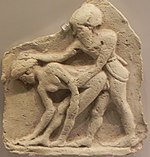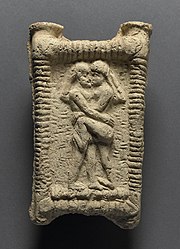User:ReikaZero/History of human sexuality
| This is the sandbox page where you will draft your initial Wikipedia contribution.
If you're starting a new article, you can develop it here until it's ready to go live. If you're working on improvements to an existing article, copy only one section at a time of the article to this sandbox to work on, and be sure to use an edit summary linking to the article you copied from. Do not copy over the entire article. You can find additional instructions here. Remember to save your work regularly using the "Publish page" button. (It just means 'save'; it will still be in the sandbox.) You can add bold formatting to your additions to differentiate them from existing content. |
Article Draft copied from History of human sexuality
[edit]The history of human sexuality studies the sexual behavior of individuals in the past, and how societies influenced the conception and experience of sexual behaviors and thoughts.[1]
The study of the history of human sexuality
[edit]
The work of Swiss jurist Johann Bachofen made a major impact on the study of the history of sexuality. Many authors, notably Lewis Henry Morgan and Friedrich Engels, were influenced by Bachofen, and criticized Bachofen's ideas on the subject, which were almost entirely drawn from a close reading of ancient mythology. In his 1861 book Mother Right: An Investigation of the Religious and Juridical Character of Matriarchy in the Ancient World Bachofen writes that in the beginning human sexuality was chaotic and promiscuous.
This "aphroditic" stage was replaced by a matriarchal "demeteric" stage, which resulted from the mother being the only reliable way of establishing descendants. Only upon the switch to male-enforced monogamy was certainty about paternity possible, giving rise to patriarchy—the ultimate "apolloan" stage of humanity. While the views of Bachofen are not based on empirical evidence, they are important because of the impact they made on thinkers to come, especially in the field of cultural anthropology.
Modern explanations of the origins of human sexuality are based in evolutionary biology, and specifically the field of human behavioral ecology. Evolutionary biology shows that the human genotype, like that of all other organisms, is the result of those ancestors who reproduced with greater frequency than others. The resultant sexual behavior adaptations are thus not an "attempt" on the part of the individual to maximize reproduction in a given situation—natural selection does not "see" into the future. Instead, current behavior is probably the result of selective forces that occurred in the Pleistocene.[2]

For example, a man trying to have sex with many women all while avoiding parental investment is not doing so because he wants to "increase his fitness", but because the psychological framework that evolved and thrived in the Pleistocene never went away.[3]

Sources
[edit]Sexual speech—and by extension, writing—has been subject to varying standards of decorum since the beginning of history. For most of historic time writing has not been used by more than a small part of the total population of any society. The resulting self-censorship and euphemistic forms translate today into a dearth of explicit and accurate evidence on which to base a history. There are a number of primary sources that can be collected across a wide variety of times and cultures, including the following:
- Records of legislation indicating either encouragement or prohibition
- Religious and philosophical texts recommending, condemning or debating the topic
- Literary sources, perhaps unpublished during their authors' lifetimes, including diaries and personal correspondence
- Medical textbooks treating various forms as a pathological condition
- Linguistic developments, particularly in slang.
- More recently, studies of sexuality
Sex in various cultures
[edit]Native American Sexuality
[edit]
The history of sexuality and gender expression varied among the vast diaspora of Indigenous tribes. The berdache, a cross-gender role existed in the tribes of the Kaska of the Yukon Territory, the Klamath of southern Oregon, and the Mohave, Cocopa, and Maricopa of the Colorado River in pre-colonial times.[4] Berdache individuals partook in the traditional roles of the other sex, including their mannerisms and labour. Cross-gender females in the Mohave tribe conducted ceremonies in which they would fully berdache females as males, giving them the right to marry women.[4] The term berdache is considered outdated in the modern era, with it being commonly replaced by the term 'two spirit' which emphasises how Native Americans themselves viewed these individuals. For most Native Americans, the person's spirit was more important than their physical body, and for them a person who transgressed from their original gender took on a third one, separate from the male or female gender.[5] Two spirit natives would often be apart of same sex relationships, as they would fulfil the necessary duties of a family unit that was expected in Native societies.[5] However, two spirit individuals of the same sex did not marry one another as the roles Native Americans played in marriages mattered more than sexuality, with sexuality not as imbedden as an identity as it is currently.[4]The cross gender identity faded away in the late 19th century due to pressure and domination by white settlers and their imposition of their sexual values and ideologies on Native American tribes, which asserted that the female gender was inferior, and that homosexuality was unnatural.[4]
Conceptions of marriage also varied among the many tribes. The Navajos for instance practiced polygamy, with customs entailing that the wives must be related or of the same clan.[6] The practice was banned in July 1945 by the Navajo Tribal Council due to pressure from the United States Government which sought to end the practice, as it enacted its own prohibitions on polygamy.[7]
Technology and sex
[edit]In the mid 20th century advances in medical science and modern understanding of the menstrual cycle led to observational, surgical, chemical and laboratory techniques to allow diagnosis and the treatment of many forms of infertility. The birth control pill introduced in the 1960s allowed women to control if and when they had children which increased their freedom, both sexually and socially.[8] The pill was illegal in many countries, including the United States and Canada, as the notion that women could prevent pregnancy with a medication incited fear in many people due to misogynistic views on women and their roles as birth givers. Some thought that the pill made women masculine, with the Catholic Church stating that only married women should be able to access it, so that single women were not encouraged to be sexually deviant.[9] The United States Supreme Court legalized the pill for unmarried people in 1974 with Eisenstadt v. Baird, and it held in 1978 that states cannot put any restrictions to access of the pill to individuals.[10]
- ^ "Sexuality – The Inclusive Historian's Handbook". Retrieved 2023-03-14.
- ^ The Adapted Mind (Google Books Link) "Cognitive Adaptations for Social Change" by Leda Cosmides and John Tooby, page 219.
- ^ The Adapted Mind (Google Books Link) On the Use and Misuse of Darwinism in the Study of Human Behavior by Donald Symons, page 137
- ^ a b c d Blackwood, Evelyn (Autumn 1984). "Sexuality and Gender in Certain Native American Tribes: The Case of Cross-Gender Females". Journal of Women in Culture and Society. 10 (1): 27–42. doi:10.1086/494112. ISSN 0097-9740 – via The University of Chicago Press Journals.
- ^ a b Williams, Walter L. (2010-10-11). "The 'two-spirit' people of indigenous North Americans". The Guardian. ISSN 0261-3077. Retrieved 2023-03-28.
- ^ Barker, Joanne (March 28, 2017). Critically sovereign : indigenous gender, sexuality, and feminist studies (1 ed.). Durham: Duke University Press. pp. 69–92. ISBN 9780822373162.
- ^ Lopez, Antoinette Sedillo (2000). "Evolving indigenous law: Navajo marriage, cultural traditions and modern challenges". Arizona Journal of International and Comparative Law. 17 (2): 283–308 – via University of Arizona.
- ^ "The Pill and the Women's Liberation Movement | American Experience | PBS". www.pbs.org. Retrieved 2023-04-04.
- ^ The Canadian Press (May 7, 2010). "Birth-control pill turns 50". CBC. Retrieved April 3, 2023.
- ^ "A Brief History of Birth Control in the U.S." Our Bodies Ourselves Today. Retrieved 2023-04-04.
Cite error: A list-defined reference with the name ":2" has been invoked, but is not defined in the <references> tag (see the help page).
